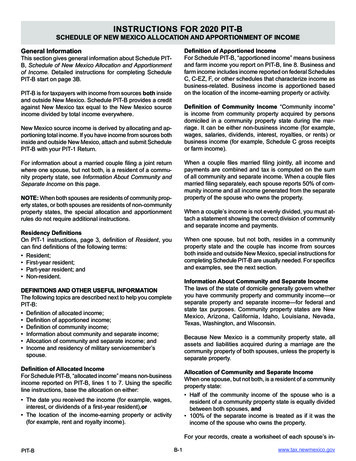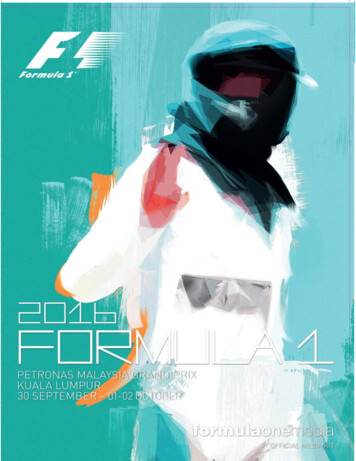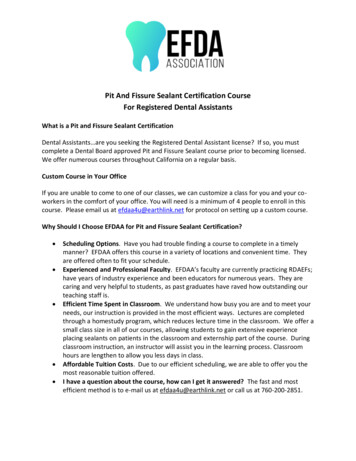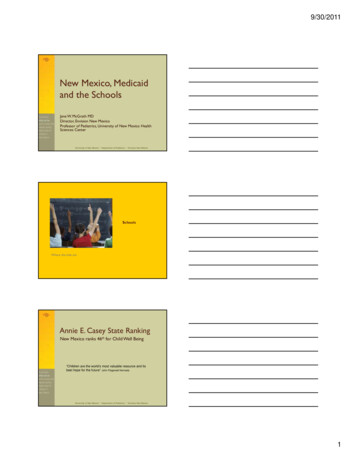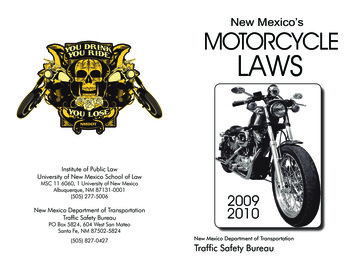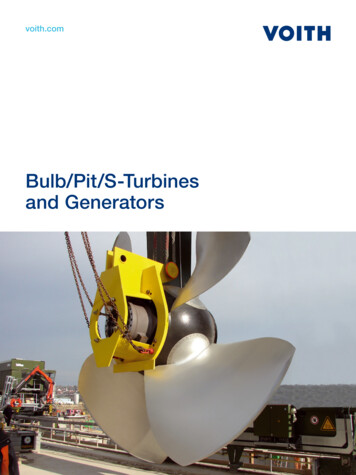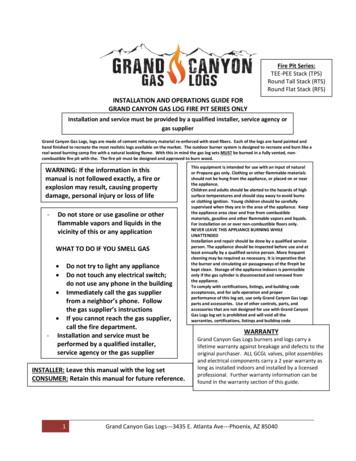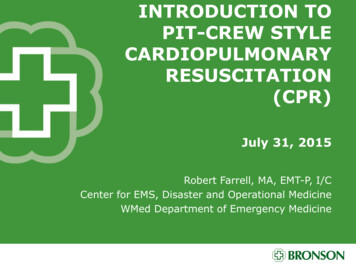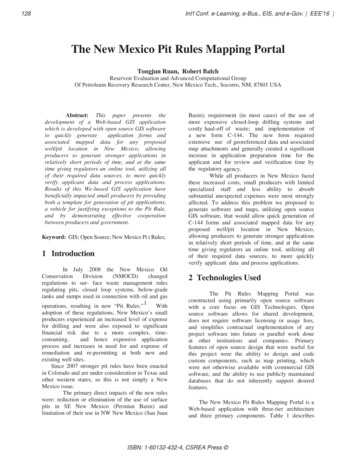
Transcription
128Int'l Conf. e-Learning, e-Bus., EIS, and e-Gov. EEE'16 The New Mexico Pit Rules Mapping PortalTongjun Ruan, Robert BalchReservoir Evaluation and Advanced Computational GroupOf Petroleum Recovery Research Center, New Mexico Tech., Socorro, NM, 87801 USAAbstract: This paper presents thedevelopment of a Web-based GIS applicationwhich is developed with open source GIS softwareto quickly generateapplication forms andassociated mapped data for any proposedwell/pit location in New Mexico, allowingproducers to generate stronger applications inrelatively short periods of time, and at the sametime giving regulators an online tool, utilizing allof their required data sources, to more quicklyverify applicant data and process applications.Results of this We-based GIS application havebeneficially impacted small producers by providingboth a template for generation of pit applications,a vehicle for justifying exceptions to the Pit Rule,and by demonstrating effective cooperationbetween producers and government.Keyword: GIS; Open Source; New Mexico Pi t Rules;1 IntroductionIn July 2008 the New Mexico OilConservationDivision(NMOCD)changedregulations to sur- face waste management rulesregulating pits, closed loop systems, below-gradetanks and sumps used in connection with oil and gas1operations, resulting in new “Pit Rules.”Withadoption of these regulations, New Mexico’s smallproducers experienced an increased level of expensefor drilling and were also exposed to significantfinancial risk due to a more complex, timeconsuming,and hence expensive applicationprocess and increases in need for and expense ofremediation and re-permitting at both new andexisting well sites.Since 2007 stronger pit rules have been enactedin Colorado and are under consideration in Texas andother western states, so this is not simply a NewMexico issue.The primary direct impacts of the new ruleswere: reduction or elimination of the use of surfacepits in SE New Mexico (Permian Basin) andlimitation of their use in NW New Mexico (San JuanBasin); requirement (in most cases) of the use ofmore expensive closed-loop drilling systems andcostly haul-off of waste; and implementation ofa new form C-144. The new form requiredextensive use of georeferenced data and associatedmap attachments and generally created a significantincrease in application preparation time for theapplicant and for review and verification time bythe regulatory agency.While all producers in New Mexico facedthese increased costs, small producers with limitedspecialized staff and less ability to absorbsubstantial unexpected expenses were most stronglyaffected. To address this problem we proposed togenerate software and maps, utilizing open sourceGIS software, that would allow quick generation ofC-144 forms and associated mapped data for anyproposed well/pit location in New Mexico,allowing producers to generate stronger applicationsin relatively short periods of time, and at the sametime giving regulators an online tool, utilizing allof their required data sources, to more quicklyverify applicant data and process applications.2 Technologies UsedThe Pit Rules Mapping Portal wasconstructed using primarily open source softwarewith a core focus on GIS Technologies. Opensource software allows for shared development,does not require software licensing or usage fees,and simplifies contractual implementation of anyproject software into future or parallel work doneat other institutions and companies. Primaryfeatures of open source design that were useful forthis project were the ability to design and codecustom components, such as map printing, whichwere not otherwise available with commercial GISsoftware, and the ability to use publicly maintaineddatabases that do not inherently support desiredfeatures.The New Mexico Pit Rules Mapping Portal is aWeb-based application with three-tier architectureand three primary components. Table 1 describesISBN: 1-60132-432-4, CSREA Press
Int'l Conf. e-Learning, e-Bus., EIS, and e-Gov. EEE'16 software components by function and use in theproject. The three primary components of the systemare:1. A database for tile-cached, collected, anddigitized data, which are stored in aPostgreSQL/PostGIS database system on a LinuxServer at the PRRC.2. An Interactive GIS with integrated data nlayer/EXT.JavaScriptprovides an interactive GIS system, which allowsusers to generate maps online based on their inputlatitude and longitude pairs for part-10 and part-17 ofForm C-144.3. Automated Form C-144: Form C-144 is a fivepage form with 25 categories and more than 100questions. To automate it online required codingsignificant interactive action/operations between theuser and the application form. Form C-144 isdisplayed and operated by the user on theclient/user side (a browser window using Firefox,Internet Explorer, or Chrome, for example) and wasdeveloped using PHP, Java and JavaScript based onEXTJS with additional AJAX and HTML codes.3 Hardware and SoftwareThe New Mexico Pit Rules Mapping Portal Serverconsists of hardware and software :Hardware: A Dell Server with 2xX5570 XeonProcessor (two quad core processors) with 32GBRAM, 5 x146GB RAID hard drive.Software: Redhat EL v5.5, pServerv5.5,Mapfishv1.1,Openlayerv2.0,EXTJS v2.1, PHP v5.2,Java v6.0 and FPDF (aPHP class which allows to generate PDF files withpure PHP).129component or map to the client’s browser.Often software will be developed witha three-layer structure consisting of a PresentationLayer, a Business Layer, and a Data Layer.Figure 1. Pit Rule Mapping Portal framework.The increasing use of web browsers and demandfor supplying interactive and dynamic informationrequires a modification of the development into athree-tier system instead, where each of the threecommon components is treated separately. Thisallows better organization of code from disparatesoftware and personnel, faster debugging, andincreases in run time efficiency with multiplecommunication paths open simultaneously. Animportant additional feature of this design is thatsoftware in each tier can be tested, modified, oraltered without impacting the other tiers since theinterfaces that allow communication between tiersremains the same. Figure 2 shows the tier-basedarchitecture for the Mapping Portal with semiautomated C-144 forms. Detailed descriptions ofeach tier are provided in following subsections.4 The framework of the Pit RuleMapping PortalFigure 1 shows the general frameworkof the Pit Rules project architecture showing bothClient and Server side software components andcommunication paths. Clients can access thesoftware using a variety of available browsers,and HTML and JavaScript code communicatestheir interactions to the database server usingmultiple pathways depending on the type of datarequested or the application being used:webservers, map servers, and application servers.The server processes the data or request andreturns the appropriate information, software sub-ISBN: 1-60132-432-4, CSREA Press
130Int'l Conf. e-Learning, e-Bus., EIS, and e-Gov. EEE'16 Figure 2. Three-tiered architecture of mappingportal.4.1 Tier 1 (Presentation Tier):The presentation tier of the Pit Rules MappingPortal is an interactive interface written inJavaScript and running on a JavaScript engine(JavaScript Interpreter) embedded in the user’sbrowser. It allows the user to perform severaloperations: obtain an account by registering; log into an existing account; manage user’s profile;create new C-144 applications; open, save/saveas/delete/download an existing application; fill indata for the C-144 Form (text and map generation);review that data and generated maps online withuser’s browser; and export the C-144 form andgenerated maps as PDF files. Key feature classesinclude:1.Registration - Allows a new user to register andsetup a name and password.2.Login - Allow registered users to login with theiruserIDs and passwords.3.User Profile - Registered users can modify orupdate their information.4.Form C-144 – Allows the user to Create, Open,Save, Save As, Delete and Download applications(Form C-144 ) in PDF format. Also allow users tofill in form online and create required maps forsubsections 10 and 17 by switching to an interactiveGIS panel.5.Interactive GIS - Allow the user to zoom in/out,go to any location by inputting Township-RangeSection, Address, zip code or latitude-longitudecoordinates. A query feature allows searches withincertain distance from the marked location. Print(copy or cut) a map with an input location as centerand related/selected features intoa PDF file for theuser to review/download.The Registration/Login/Profile/Form C-144forms are implemented with JavaScript withEXTJS. The Interactive Maps are implementedwith JavaScript using MapFish/EXTJS.and MapServer4. Maps process -- Implemented with MapServerand Java Servlets5. PDF form generator -- Implemented with PHPbased on the FPDF package.4.3 Tier 3 (Data Tier):Tier 3 is the data layer that represents the databaseof geology and geographical features of NewMexico, user data (profiles and Form C-144 saveddata) on the PostgreSQL/PostGIS Server and projectgenerated map data files as well as data connectionsor tile caches from external server such as Googlemaps, USGS, University of New Mexico (UNM),and others. The data Tier also manages PHPcodes for Sections 1, 2, 3, and 5 in Tier 2 andcontrols allaccess to data and map data files fromTier 2 software. The Java Servlets for printingmaps (Section 4 code in Tier 2) access map data inPostgreSQL/PostGIS through Java DatabaseConnectivity (JDBC).5. ImplementationIn Figure 3 the left panel allows data selection,the right top panel provides tools, the right centerpanel displays mapped features, and the bottompanel provides additional information.The data selection panel, which wasimplemented with EXTJS, is expanded in Figure 4showing four distinct functions. The first functionis to display mapped data relevant to C-144attachments. Map layers are divided into baselayers and overlays. Only one base map may beselected at a time, while multiple overlays can bedrawn on top of a single base layer. An example ofthis is shown in Figure 5, where the New Mexicogeologic map is overlain upon topographic data.4.2 Tier 2 (Business Tier):There are five sections of the MappingPortal that interact and mediate between Tier 1 andTier 3.The task of the business tier is tointeractively collect data from the user and processthe data or query to the appropriate sections of Tier 3.The five major processes are:1. Registration/login process -- Implemented withPHP2. Profile process -- Implemented with PHP3. Form C-144 process -- Implemented with PHPFigure 3. The Pit Rule Mapping Portal.5.1 Map LayersISBN: 1-60132-432-4, CSREA Press
Int'l Conf. e-Learning, e-Bus., EIS, and e-Gov. EEE'16 Map layers are as follows with the first fourrepresenting the base layers:1. No Base Layer – Only overlain maps are isplayed2. USGS TOPO – US Geologic Survey topographicmaps are is played 2005/06 Aerial (RGIS) – aerialphotos for New Mexico are displayed1313.4.5.6.7.8.9.10.11.12.13.Shaded Relief – A digital terrain model isdisplayedDrilling Pad Radii – C-144 distances drawn asrectangles from average drilling padSite Marker – shows selected site location on themapSite Radii – C-144 distances drawn as circlesfrom the site markerNew Mexico Geology – Geologic map of NewMexicoUSGS Karst Map – USGS Karst Terrain mapLand Ownership – Land OwnershipMines and Minerals – Surface and subsurfaceminesPolitical Boundaries – Roads, counties, cities andLand GridSurface Water – Streams, rovers, ponds, lakes,reservoirs, playas, swamps, springs, etcStatewide Wells – OSE water wells, USGSgroundwater data, and oil and gas wells5.2 Print single pageFigure 4. Expanded Data Panels. UpperLeft shows map layers, upper right showsPrint feature, lower left shows thelocation tool, and lower right shows thequery feature.The Print single page panel can be used togenerate PDF printouts for any generated map.When the Print panel is selected the user ispresented with boxes for a title, Client name, FigureNumber, and Scale. A yellow, moveable boxappears on the screen, centered on the site location,which shows the area that will be converted to aPDF when the print button is selected. Figure 6shows an active map panel and Figure 7 shows theresulting map.Figure 4 (lower left) shows the Go to Locationpanel. The user can enter locations as an address,latitude and longitude or in township-section-rangeformat by selecting the appropriate tab.Figure 5 New Mexico geologic map overlainon topographic data. Also shown are politicalboundaries, major cities and roads.Figure 6. Active Map Panel. Users can enterpersonalized information for the captions,and the movable yellow area represents the mapimage. In this case the site is within 1000 ft ofISBN: 1-60132-432-4, CSREA Press
132Int'l Conf. e-Learning, e-Bus., EIS, and e-Gov. EEE'16 surface water, which is overlain on aerial photodata.When the location is entered the map willzoom into that location at a scale that is appropriatefor generating C-144 attachments.Identify features. Also shown are water wells(blue squares), oil and gas wells (orangecircles), surface water (blue lines), and theNew Mexico land grid (brown lines andlabels).6 Results for the New Mexico PitRule Mapping Portal with Form C144Figure 7. PDF image generated using the Printsingle page panel.5.3 QueryThe Query panel allows searching the OSE andUSGS water data for features within a specifieddistance. Figure 8 shows a shaded relief mapbase layer with pad radii, OSE water wells, oiland gas wells, surface water and the New MexicoLand grid as overlays. Note that the water well datashows depth to groundwater and date measured.Water wells within 1000 ft have been queried andare listed in a table in the Query panel. Thequery feature is also available using the tool barmenu Identify feature, which allows the user todrag a box on the screen and query the featurecontained within that area. When the Identifyfeature is used the query results pop up on thescreen. In this example the same five water wellshave been queried.Figure 8. Query and Identify features.Tabulated water well data was extracted fromthe OSE database using both the Query and theIn order to utilize the digitized C-144 form a userwould select Pit Rules Mapping Portal WithForm C-144 at the entry page. Since the C-144form utilizes a database to store maps and forms foreach user, a simple login procedure is used toensure that data is easily and correctly stored andretrieved. Therefore a login is required and if theuser has not previously registered with the system arequest for profile information pop-up query will beinitiated. After the user fills in requiredinformation the login will be processed and amodified version of the mapping portal will beinitiated (Figure 9) which has three separate tabs:Profile, which allows the user to modify theirregistration data; Forms, which allows the user tomanage their existing applications and create newapplications; and Map, which provides access tothe mapping portion of the Pit Rule Mapping Portal.In the Forms tab, user application data is storedin folders by year and month. Any appli- cationsstarted in November of 2011, for example, wouldreside in a folder named “2011-11”. Users canreopen a previous application to continue, or revisemaps, or create a new application. When a newapplication is initiated users can give any name theydesire, such as API, well name, or unit number.After the application is opened users have access toan interactive version of the C-144 form and canenter baseline information such as OGRID number(operator ID code) well location, company name,and other basic information. They can also createmaps in sections 10 and 17 for required attachments.Each siting criteria has two associated buttons:Create Map, which opens the Map tab andautomatically zooms to the applications location andturns on appropriate layers for determining thestatus of the location with respect to the criteria;and a button labeled Attached 10-X, which is aplaceholder for the map name users will supplywhen they save the map. This second buttonallows retrievable of previously examined andstored maps. Additional options within the Formtab are Save, Save As, Download, and Reset.ISBN: 1-60132-432-4, CSREA Press
Int'l Conf. e-Learning, e-Bus., EIS, and e-Gov. EEE'16 Features of the forms page are shown in Figure 9.Figure 9. Interface for Pit Rule MappingPortal with Form C-144. Section 10 withinterac- tive map generation is shown in thisexample.Figure 10. Sample of an automaticallygenerated map for siting criteria 10-2. Thisexample demonstrates that the site is greaterthan 500 feet from any surface water channels.133software to quickly and automatically generateapplication forms and associated mapped data forany proposed well/pit location in New ions in relatively short periods of time, andat the same time giving regulators an online tool,utilizing all of their required data sources, tomore quickly verify applicant data and processapplications. Results of this We-based GISapplication have beneficially impacted smallproducers by providing both a template forgeneration of pit applications8 References1. Robert Balch , Tongjun Ruan, “ReducingImpact of New Mexico New Pit Rules OnSmall Producers”, 20112. PostgreSQL v9.0 Manual, 20143. PostGis v2.2.3 manual, 20154. http://mapserver.org/,20125. http://mapfish.org/,20126. http://openlayers.org/,20127. http://www.ext.net/,20128. http://www.sencha.com/extjs, 20159. http://ajaxian.com/by/topic/ajax,201510. http://www.commonjs.org/,201511. http://java.com/en/,201512. http://tomcat.apache.org/,201513. http://www.php.net/,201514. http://www.fpdf.org/,2015Figure 1 0 shows an automatically generatedmap showing proximity to surface water. Thetopographic sheet base layer has been set, andoverlays for Site Marker, Pad Radii, PoliticalBoundaries and Surface Water have been turnedon. This map can be saved to the form and/orprinted using the Print Single Page panel asdemonstrated in Figures 6–7. User- generated mapsand forms are stored indefinitely on servers at thePRRC in case adjustments or additions need to bemade to successfully complete a C-144 form.7 ConclusionThe New Mexico Pit Rules Mapping Portal, a Web-based GIS application, has beensuccessfully developed with open source GISISBN: 1-60132-432-4, CSREA Press
EXTJS with additional AJAX and HTML codes. 3 Hardware and Software The New Mexico Pit Rules Mapping Portal Server consists of hardware and software : Hardware: A Dell Server with 2xX5570 Xeon Processor (two quad core processors) with 32GB RAM, 5 x146GB RAID hard drive. Software: Redhat EL v5.5, PostgreSQL, PostGIS,Apache v2.2,Apache-Tomcat v5.5,


